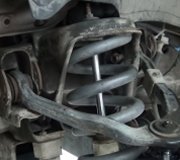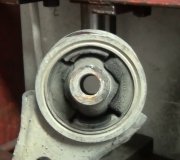It doesn't matter. The truck has to be aligned right after those arms were replaced. They will take care of the leaning wheels. Most of those trucks came with square blocks that had to be switched out for round offset "cam" washers at the first alignment. The engineers didn't bother to make the truck alignable from the factory. On other models, you have to make the bolt holes oblong by grinding them oval-shaped with a small die grinder to allow them to be adjusted. If one of those procedures was done already, loosen the pivot bolts, then rotate them to draw the control arm in. That will stand the wheels up straighter, but that is only part of the story. Moving the top of the wheel in or out on top is called the "camber" angle. That's the first of the three main alignment angles.
The second angle is called "caster". That one has very little effect on tire wear, but it has a real big effect on pulling to one side and steering wheel return after cornering. Caster changes as the upper ball joint is moved forward or rearward. That is done by moving one upper control arm pivot bolt out and the other one in. The control arm is a giant triangle. Keeping one corner in place and moving a second corner causes the third corner to move.
Since both pivot bolts are used to adjust caster and camber, they have to be jockeyed back and forth until both angles are in specs at the same time. Then both sides need to have both angles the same. That makes the job a lot more difficult to get everything right.
Most suspension and steering parts, including control arms, are never exactly the same. That's why the vehicle needs to be aligned any time one of them is replaced. There's other things that will be checked before a specialist will take your money for an alignment. The most important is chassis ride height. If that is not within the published legal range, it changes the geometric relationship of the steering and suspension parts. That changes the motions the wheels go through as the truck bounces up and down. With sagged ride height, you will have accelerated tire wear even when the numbers on the alignment computer look perfect.
You'll want to tell the alignment specialist that you replaced the upper control arms. He's still going to inspect the rest of the systems for anything that would prevent the alignment from holding, but there's one other thing he will do as long as he's aware of the parts you replaced. That has to do with how the truck was sitting when you tightened the pivot bolts. Most of us do that with the wheels off and the vehicle supported on jack stands. That lets the suspension parts hang down freely. That is not the time to tighten the pivot bolts. When the truck is lowered onto the ground, the control arms are going to pivot up to their at-rest positions. If the pivot bolts were already tightened, the bushings will be clamped in a permanent twist. That will seriously shorten the life of those rubber bushings. Knowing the need to do this, the mechanic will loosen, then retighten the bolts while the truck is sitting at normal ride height on the alignment rack.
The third alignment angle is "toe". That's the direction the wheels are steering when the steering wheel is straight ahead. If you look at the tie rod ends / steering linkage where they connect to the spindles, you'll see that point is higher off the ground than the lower ball joint, but not as high as the upper ball joint. That means when the upper ball joint is adjusted out, lets say an inch, the steering arm on the spindle is going to move out about a half inch. Since the steering linkage didn't change, it is too short now and will cause the spindle and wheel to turn left or right. That can easily cause toe to change as much as a couple of inches. 1/8" out-of-specs is enough for toe to cause scrubbing on both tires. Incorrect toe also can cause a real lot of steering wander and a miserable truck to drive.
Adjusting toe causes caster and camber to barely change at all, but adjusting caster or camber causes a real lot of toe change. That's why toe is always adjusted last.
Most alignment computers can make a printout that includes the "Before" readings, meaning before anything was adjusted, and the "After" readings after the alignment is completed. Ask for a printout as some shops don't automatically give them to customers. If you post the numbers for caster, camber, and toe, I can interpret them for you and show you what the mechanic did for your truck.
Saturday, May 15th, 2021 AT 5:44 PM



